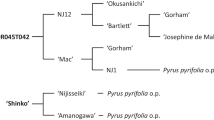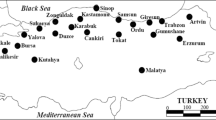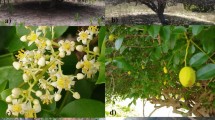Abstract
Isoenzyme electrophoresis was used as a method to determine genetic diversity in various M. esculenta cultivars collected in the Southwestern (SW) and Northwestern (NW) regions of the State of Parana, in the South region of Brazil, and in cultivars produced at the Agronomic Institute of Campinas (IAC), S~ao Paulo State, Southeastern region of Brazil. The cultivars have been maintained by vegetative propagation for 5 years and are useful in production programs. A total of 28 loci in the acid phosphatase (ACP; EC 3.1.3.2), esterases (EST; EC 3.1.1.1), malate dehydrogenase (MDH; EC 1.1.1.37), and shikimate dehydrogenase (SKDH; EC 1.1.1.15) isozymes was analyzed. The proportion of polymorphic loci for NW, SW, and IAC cultivars was 57.14, 50.0, and 53.6%, respectively. Genetic diversity calculated by Nei's genetic identity (I) showed high I values for the three M. esculenta subpopulations. The high degree of polymorphism expressed by cassava cultivars is highly relevant to stimulate breeding programs with M. esculenta species.
Similar content being viewed by others
REFERENCES
Brondani, C. (1996). —Variação isoenzimática de três espécies do gênero Manihot (Euphorbiaceae) relacionadas morfologicamente à mandioca (Manihot esculenta Crantz). Pesq.Agropec.Bras. 31:287.
Brown, A. H. D. (1989). Genetic characterization of plant mating systems. In Clegg, M. T., Kahler, A. L., and Weir, B. S. (eds.), Plant Population Genetics, Breeding, and Genetic Resources, Sinauer Associates, Sunderland, MA, pp. 145–162.
Chavarriaga-Aguirre, P., Maya, M. M., Tohme, J., Duque, M. C., Iglesias, C., Bonierbale, M. W., Kresovich, S., and Kochert, G. (1999). Using microsatellites, isozymes and AFLPs to evaluate diversity and redundancy in the cassava core collection and to assess the usefulness of DNA-based markers to maintain germplasm collections. Mol.Breed. 5:263.
Chernela, J. M. (1983). —Os cultivares de mandioca na área do uaupés (Tukâno). In Ribeiro D. (ed.), SUMA Etnológica Brasileira, 2nd ed., Vozes, Finep, Rio de Janeiro, pp. 151–158.
Coates, P. M., Mestriner, M. A., and Hopkinson, D. A. (1975). A preliminary genetic interpretation of the esterase isozymes of human tissues. Ann.Hum.Genet. 39:1.
Cock, J. H. (1982). Cassava: A basic energy source in the tropics. Science 218:755.
Colombo, C., Second G., Valle, T. L., and Charrier, A. (1998). Genetic diversity characterization of cassava cultivars (Manihot esculenta Crantz). I) RAPD markers. Genet.Mol.Biol. 21:105.
Crawford, D. J. (1989). Phylogenetic and systematic interference from electrophoretic studies. In Tanksley, S. D., and Orton, T. J. (eds.), Isozymes in Plant Genetics and Breeding, Part A, Elsevier Science, Amsterdam. pp. 257–287.
Gonçalves-Vidigal, M. C., Vidigal-Filho, P. S., Amaral-Júnior, A. T., and Braccini, A. L. (1997).—Análise de parâmentros genéticos e correlações simples e canônicas entre características morfoagronômicas e da qualidade das raízes em cultivares de mandioca (Manihot esculenta Crantz) adaptadas ao Noroeste Paranaense. Rev.Bras.Mand.Cruz das Almas (BA) 16:41.
Grattapaglia, D., Costa e Silva, C., and Nassar, N. M. A. (1996). Strict maternal inheritance of RAPD fingerprint confirms apomixis in cassava (Manihot esculenta Crantz). Can.J.Plant Sci. 76:379.
Hopkinson, D. A., Mestriner, M. A., Cortner, J., and Harris, H. (1973). Esterase-D: A new human polymorphism. Ann.Hum.Genet. 37:119.
Hussain, A., Ramirez, H., Roca, W., and Bushuk, W. (1987). Identification of cassava (Manihot esculenta Crantz) by electrophoretic patterns of esterase isozymes Seed Sci.Technol. 15:19.
Jorge, I. C., Mangolin, C. A., and Machado, M. F. P. S. (1997). Malate dehydrogenase isozymes (MDH; EC 1.1.1.37) in long-term callus culture of Cereus peruvianus (Cactaceae) exposed to sugar and temperature stress. Biochem.Genet. 35:155.
Lefèvre, F., and Charrier, A. (1993a). Isozyme diversity within African Manihot germplasm. Euphytica 66:73.
Lefèvre, F., and Charrier, A. (1993b). Heredity of seventeen isozyme loci in cassava (Manihot esculenta Crantz). Euphytica 66:171.
Machado, M. F. P. S., Prioli, A. J., and Mangolin, C. A. (1993). Malate dehydrogenase (MDH; EC 1.1.1.37) isozymes in tissue and callus cultures of Cereus peruvianus (Cactaceae). Biochem.Genet. 31:167.
Mitton, J. B. (1989). Physiological and demographic variation associated with allozyme variation. In Soltis, D. E., and Soltis, P. S. (eds.), Isozyme in Plant Biology, Dioscorides Press, Portland, OR, pp. 127–145.
Nassar, N. M. A. (1992). Cassava in South America: A plant breeder's view. Ci.Cult.J.Braz.Ass.Adv.Sci. 44:25.
Nassar, N. M. A. (1994). Development and selection for apomixis in cassava, Manihot esculenta Crantz. Cienc.Cult. 46:168.
Nassar, N. M. A., and Grattapaglia, D. (1986). Variabilidade de clones de mandioca em relação a fertilidade e aspectos morfológicos. Turrialba 36:555.
Nassar, H. N. M. A., Nassar, N. M. A., Vieira, C., and Saraiva, S. (1993). Interspecific hybrids of cassava with wild Manihot species and their cytogenetic behaviour. Can.J.Plant Sci. 73:244.
Nassar, N. M. A., Vieira, M. A. R., Vieira, C., and Grattapaglia, D. (1998). Evidence of apomixis in cassava (Manihot esculenta Crantz). Genet.Mol.Biol. 21:527.
Nei, M. (1972). Genetic distance between populations. Am.Nat. 106:283.
Newton, K. J. (1983). Genetics of mitochondrial isozymes. In Tanksley, S. D., and Orton, T. J. (eds.), Isozymes in Plant Genetics and Breeding, Part A, Elsevier Science, New York, pp. 159–176.
Ramirez, H., Hussain, A., Roca, W. M., and Bushuk, W. (1987). Isozyme electrophoretograms of sixteen enzymes in five tissues of cassava (Manihot esculenta Crantz) varieties. Euphytica 36:39.
Swofford, D. L., and Selander, R. B. (1989). BIOSYS 1.A Computer Program for the Analysis of Allelic Variation in Population Genetics and Biochemical Systematics, Release 1.7, University of Illinois, Urbana.
Tashian, R. E. (1969). The esterases and carbonic anhydrases of human erythrocytes. In Yunis, J. J. (ed.), Biochemical Methods in Red Cell Genetics, Academic Press, New York, pp. 307–336.
Author information
Authors and Affiliations
Rights and permissions
About this article
Cite this article
Resende, A.G., Filho, P.S.V. & Machado, M. Isozyme Diversity in Cassava Cultivars (Manihot esculenta Crantz). Biochem Genet 38, 203–216 (2000). https://doi.org/10.1023/A:1001963319965
Issue Date:
DOI: https://doi.org/10.1023/A:1001963319965




